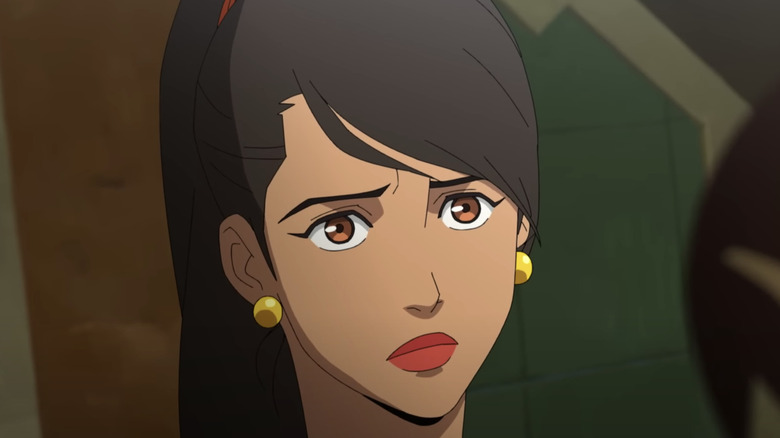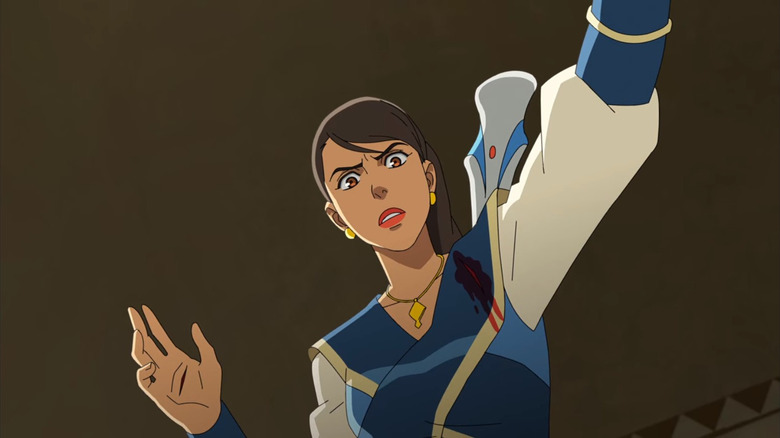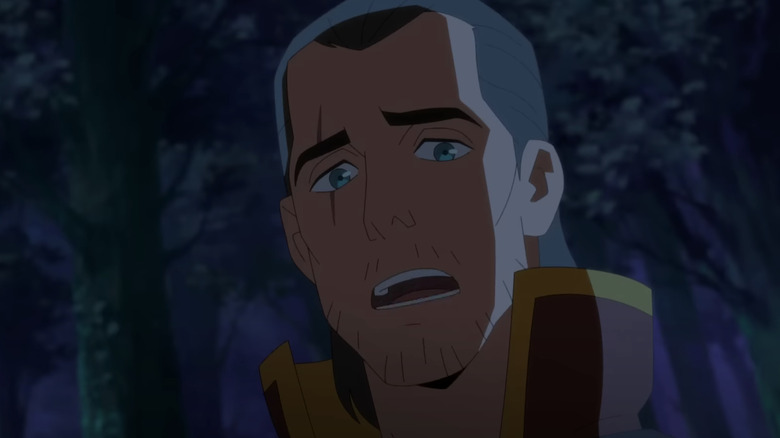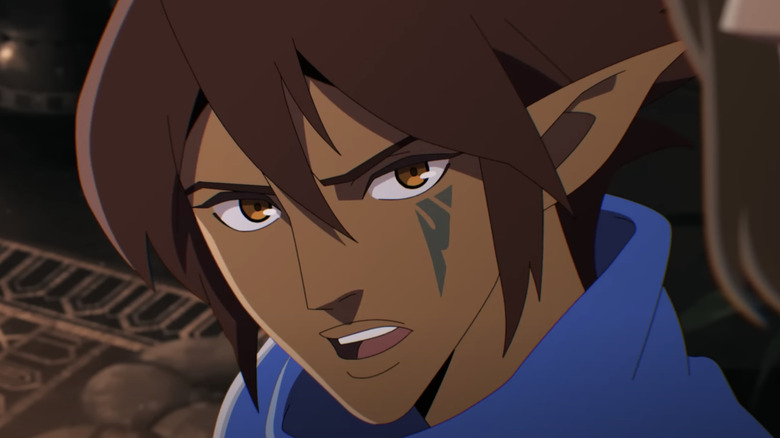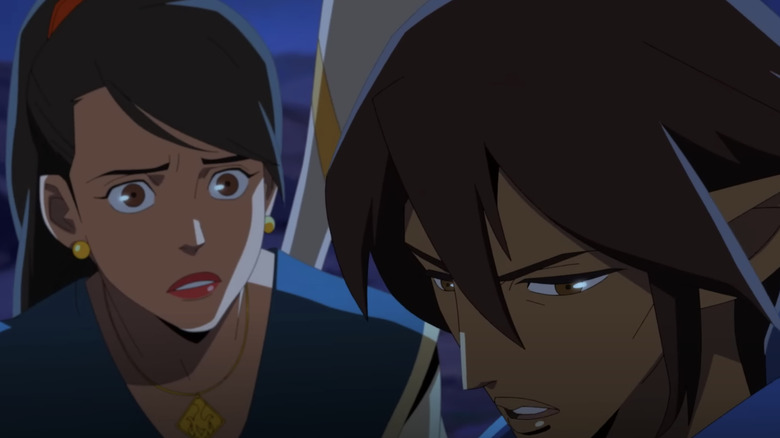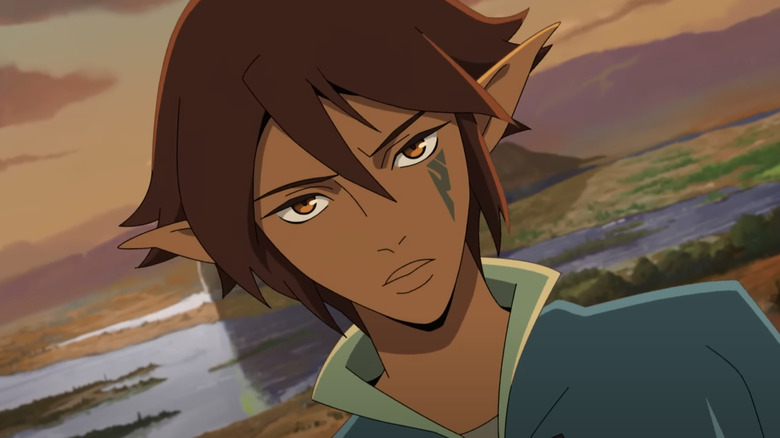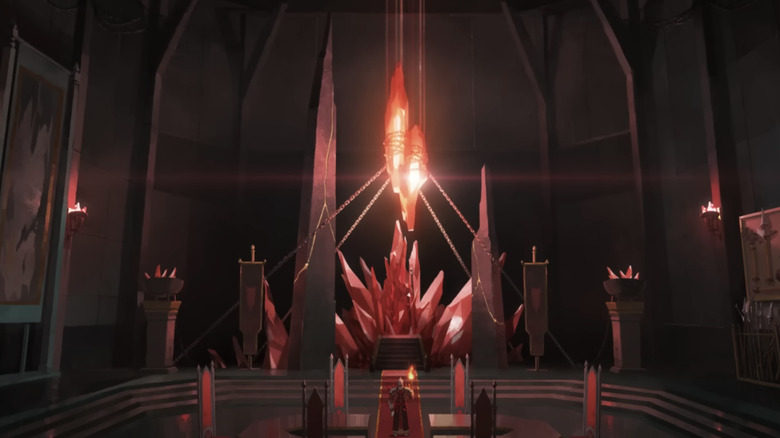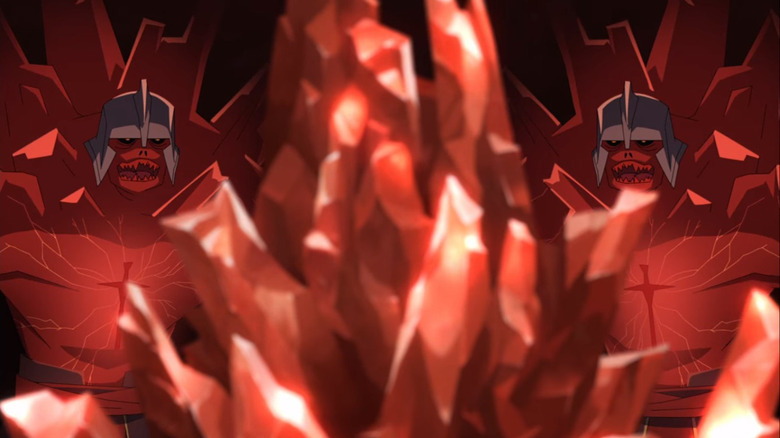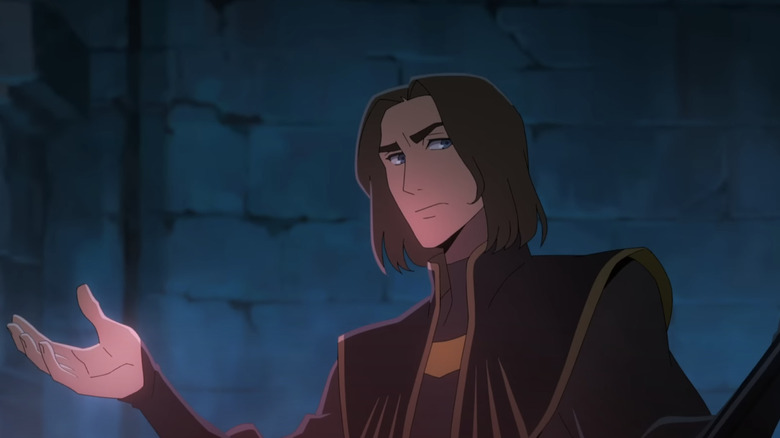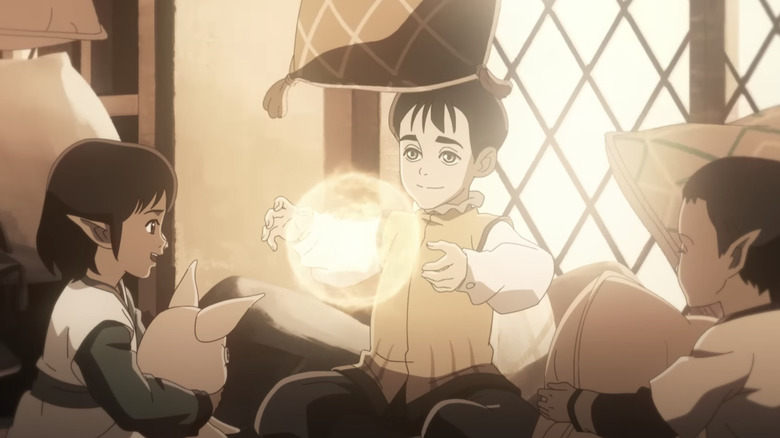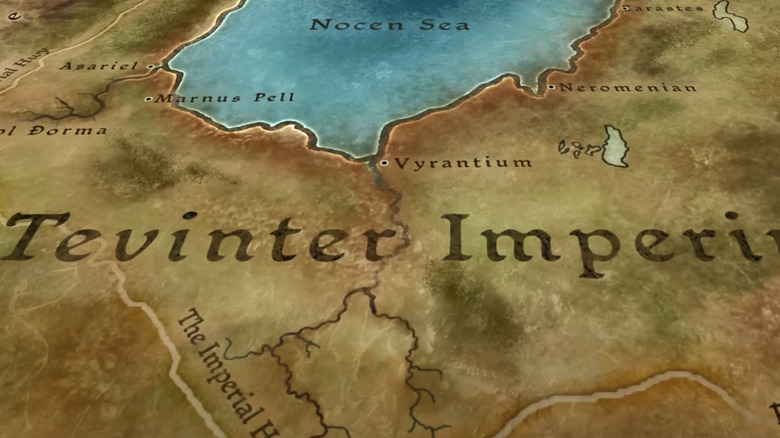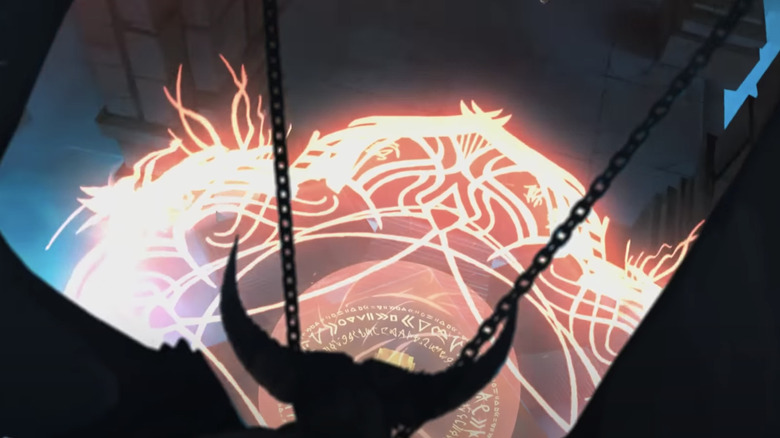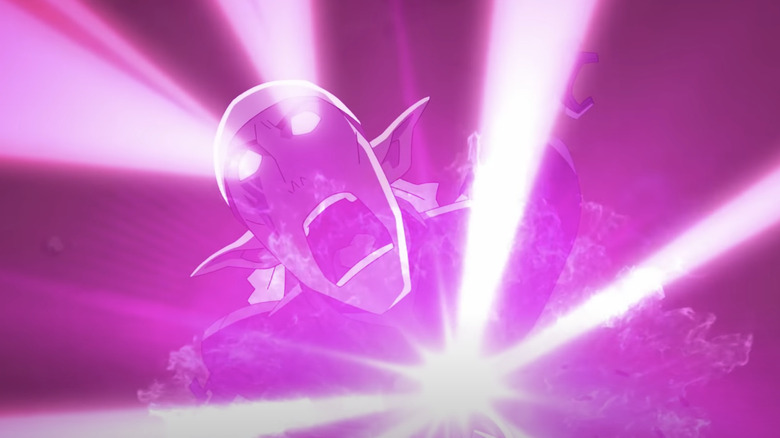The Ending Of Dragon Age: Absolution Explained
"Dragon Age: Absolution" has had fans on the edge of their seats, and the season finale arguably left us with as many questions as it did answers. The show follows a gang of mercenaries on a quest to retrieve the stolen Circulum Infinitus, and the possibilities of power, strength and forbidden magic are put to the test. "Dragon Age: Absolution" follows the success of the video game franchise (via IGN), each detailing a different facet of the same fantasy world. Some characters have crossed over from game to screen, and the season finale only sets them up for further drama.
With "Dragon Age: Dreadwolf" on the horizon (via Gamespot), the season finale of "Dragon Age: Absolution" can tell us a great deal about where things might be heading. From villainous forces we've seen before, to family honor and the ultimate acts of betrayal, there's far too much to wrap up in the team's story in just six episodes. But where does the show go from here? We think we have an idea. Here's the ending of "Dragon Age: Absolution" explained. Spoilers ahead.
We know who has the Circulum Infinitus
Throughout Season 1 of "Dragon Age: Absolution," our gang of mercenaries has been hell-bent on recovering the Circulum Infinitus after the initial heist goes wrong. Before the season finale, viewers have been led to believe that Fairbanks was the traitor behind the fallout. Though Hira seems to be the first of the group to discover the Infinitus, she is revealed to be the actual perpetrator of the crime. It's a revelation that puts a further strain on her complicated relationship with Miriam — who until now has been deceived by Hira's intentions.
Though Hira's narrative journey could be seen as disappointing, the events of the season finale could set her up for a redemption arc. As some fans have noticed, Hira's double-crossing actions seem to be a painfully obvious choice — even if it is a case of keeping your enemies close. Now that she has been found out, could this be a case of working your way back up from rock bottom?
Fairbanks has his name cleared but at a cost
Fairbanks is one of the main cast members previously featured in the "Dragon Age" games and has become one of the characters that fans are most invested in. The leader of the heist during this season, Fairbanks establishes himself as a talented thief and an expert safe cracker. Therefore — with his natural prowess for thievery — it's not surprising that he is accused of taking the Circulum Infinitus. This seems to be confirmed further when Hira breaks the seal around the artifact and Fairbanks stabs her and escapes. It's not until later that we know his real reasons for doing so, and it puts an interesting chain of events in motion for future seasons.
A maverick with a natural knack for leadership, Fairbanks only has his name cleared after he dies. His death feeds into the overarching themes of betrayal and revenge at the core of "Dragon Age: Absolution" — with fans of the previous games catching onto the fact Fairbanks would be an extremely unlikely double-crosser. While Fairbanks won't feature in any future seasons or spinoffs, his actions and legacy could influence subsequent storylines, as the other characters learn to sit with their grief.
Miriam might be more naive than we think
Miriam — an elven mercenary who escaped enslavement back in Tevinter — should be the dictionary definition of street smart. Yet as the drama unfolds in the season finale of "Dragon Age: Absolution," she proves herself to be anything but. Miriam is deceived multiple times as things start to go awry with the team's heist to retrieve the Circulum Infinitus. Firstly, she lets herself be persuaded by others that Fairbanks was guilty of stealing the ancient artifact — which could largely be thanks to her growing attraction to Hira. Later, Miriam is deceived by Hira herself — learning their romantic connection has resulted in little more than her being used.
On the one hand, it's something fans could have seen coming. As one of the rookie members of the team, it's understandable that Miriam might sometimes be a beat behind the rest. At the same time, her childhood hardship and years as a slave suggest that she should be able to recognize trouble when it appears. Either way, fans have been puzzled by Miriam's character development — something that needs to be ironed out in future seasons.
Hira and Miriam have more history to be explored
One of the key relationships in Season 1 of "Dragon Age: Absolution" is between Hira and Miriam. When they are first introduced, we learn that Hira and Miriam have an existing history. Miriam first met Hira when she left Tevinter, and the pair quickly fell in love. Details remain unclear, but Hira previously wished to join the Inquisition while Miriam didn't — leading Hira to fight in the Breach and ultimately leave Miriam. By the time the finale gets underway, the pair seem to be fighting for the same side — trying to retrieve the Circulum Infinitus — except Hira has been lying to Miriam the entire time.
This leaves us with plenty of questions about their relationship. If they had been in love and developed a meaningful relationship, surely they would know each other's characteristics inside out. This is clearly the case for Hira — who is able to hoodwink Miriam into believing whatever she wants her to. Miriam, on the other hand, is less knowledgeable, potentially blinded by love, and so focused on the quest that she fails to see Hira for who she truly is. What happened during all that time they spent apart, and what happens next should definitely be explored further.
Miriam has a lot of baggage
Miriam's past shapes everything she does throughout "Dragon Age: Absolution." Alongside her romantic entanglement with Hira, she's also linked to arch-nemesis Rezaren. Brought up by Rezaren's mother in the House Ammosine, Miriam and her brother Neb are raised to be assassins for the younger Rezaren. They were both routinely abused by her to remind them of their status — with Neb later sacrificed to help Rezaren's powers — leaving Miriam to kill the matriarch. Both Miriam and Rezaren explore these ties throughout the season finale, though it's Miriam's arc that leaves fans with more questions than answers.
As some fans have pointed out, Miriam doesn't have a solid reason to hate Rezaren the way she does. Neb's fate was tied to him, but as Rezaren points out, you can't blame a child for something an adult chooses to do. Even as the episode draws to a close, there's a lack of resolution here. It could be a deliberate decision to keep something back for future seasons, but if left unresolved it could leave viewers confused and unsatisfied with how "Dragon Age: Absolution" concludes.
Who is in the red lyrium?
As we learn throughout the first season, lyrium is incredibly important to magic — with red lyrium sitting at the nastier end of the spectrum. Before the season finale, we've already seen how lyrium can be used incorrectly — when Rezaren dipping his hands into lyrium during the Harrowing went terribly wrong. This time, lyrium is used in the parting shots, encasing the person who's destined to propel future seasons and spinoffs forward. Unlike blue lyrium — used for good magic — red lyrium signifies that evil will spearhead the destiny of "Dragon Age: Absolution."
So who is the person encased inside? We learn that it is none other than the Crimson Knight. Fitting to their name, Hira's previous accomplice is now set up to be the overarching villain for future installments — shown dictating orders to bring Hira down for what she has done. A villain that is already linked to the wider "Dragon Age" story, it's an interesting decision to bring them into the fold. There's potential for even more chaos — given that many fans don't know the limits of their powers. We may have briefly seen what the Crimson Knight is capable of, but they're likely to play an even bigger part in the story going forward.
The mystery of the Crimson Knight is solved
For dedicated fans of the "Dragon Age" franchise, the Crimson Knight should be a familiar figure. At the end of the "Dragon Age II" video game, the Crimson Knight is seen to be petrified by a red lyrium sword — explaining the state we find them in during the finale of "Dragon Age: Absolution." Clues from the game can also lead us to confidently guess just who the Crimson Knight might be. Hira mentions taking the Circulum to someone she knows in Kirkwall early in the final episode, but doesn't mention the plan to turn the Templars against Tevinter from within.
With this in mind, it's most likely that the Crimson Knight is actually Knight Commander Meredith Stannard. Playing the role of Knight Commander of the Templars of Kirkwall in "Dragon Age II," it makes complete sense for Hira to keep certain information to herself if she's to overthrow the next major villain. We also already know that Meredith was set up to be a villainous force when first introduced, meaning her evil capabilities could know no bounds.
Hira and Rezaren are weirdly alike
By the time we reach the final episode of "Dragon Age: Absolution," Hira and Rezaren show character traits that make them more alike than we'd previously thought. The obvious tie-in — that could definitely be expanded on in future seasons — is that both are propelled by unexpected betrayal. Rezaren's betrayal is bigger scale, often turning to blood magic to get his own way. His lover Tassia becomes concerned — convinced that his obsession with his rise to the top will lead him down darker paths.
Hira's actions prove to be similar to Rezaren's, committing the ultimate betrayal of stealing the Circulum Infinitus. They also both share a sense of status, naturally seeing others as beneath them. While both are wicked, their reasonings vary. Rezaren has issues in his past that clearly lead him towards a path of destruction, while Hira's motives are still somewhat unclear. Looking ahead to Season 2, it's likely we'll see the pair's backstories delved into further, with the possibility of them both being lured toward the evil side of magic.
Restoring family honor
Like many other magical epic fantasies, the "Dragon Age: Absolution" season finale explores the idea of restoring family honor. Looking at the team's quest at face value, individual and collective honor is a great motivator. Success in the quest will obviously make them all seem heroic, and those with negative reputations would receive some redemption. But at a deeper level, their actions and decisions to join the Inquisition could be tied to the resolution of some past family trauma.
This is particularly true for both Rezaren and Miriam. Rezaren is seen by his family as a failure, following the events of the Harrowing that prompted Neb's sacrifice. Successfully becoming the hero who found the Circulum Infinitus could put Rezaren back in favor with the House Ammosine. For Miriam, it's a chance to avenge her brother's death. By becoming the powerful mage that he wasn't allowed to be, Miriam might feel that his death becomes worth something. The fallout of Hira's betrayal is yet to be seen, but it could result in further exploration of the characters' backstories and the implications this has on their future actions.
The story needed more time
Limited seasons can be great for binge-watching, but not so great for the stories themselves. In the case of "Dragon Age: Absolution," some fans feel as if the overall narrative is underdeveloped (via Polygon). When it comes to the world of fantasy magic, there's often an overwhelming sense of depth and lore to be explored. Shows such as "Game Of Thrones" and "The Witcher" span across multiple seasons, books, and spinoffs — able to take the time to world-build in a way fans will find satisfying. Though the video games do provide some of the background, the first season of "Dragon Age: Absolution" arguably needs more time.
With a team of quirky and complex thieves, their stories were never going to be successfully explored collectively over six episodes. Main characters such as Miriam and Hira still have large chunks of their backstory left untold, while minor characters like Qwydion don't get as much airtime. While this is positive news for a second season, it can make the events of the season finale feel confusing.
There's more to be explored with Dragon Age: Dreadwolf
Where "Dragon Age: Absolution" might be lacking in world-building, the upcoming and highly anticipated "Dragon Age: Dreadwolf" game will hopefully help to fill in the gaps. There's plenty that "Dragon Age: Absolution" can tell us about what lies ahead, particularly given that we know we'll be taken back to the world of Tevinter (via Paste). Some of the characters are expected to be included in the "Dreadwolf" story, such as Fairbanks and Hira, and with so much of Miriam's world and backstory tied into Tevinter, it also seems likely that she will be featured in some capacity.
It's also probable that it will pick up on the face of the Inquisition itself in greater depth. "Dragon Age: Absolution" references the inquisitor as the Herald of Andraste: What does this mean? We're not completely sure. But it's an obvious thread to carry forwards into "Dragon Age: Dreadwolf." Given the fact that the Crimson Knight has also been referenced in previous games, "Dragon Age: Absolution" also perfectly sets up the next gaming installment to explore what she's been up to.
What can we expect from Season 2?
As Season 1 of "Dragon Age: Absolution" has only just hit our screens, plans for a second season are still up in the air. Currently, Netflix hasn't revealed any plans for future installments — but this isn't necessarily a bad thing. While the streaming service has developed a reputation for quickly canceling its new shows (via Wired), there's no indication that "Dragon Age" content should suffer the same fate. The fact it already has an existing fanbase is a huge advantage, allowing the show the same kind of scope that "Heartstopper" had to explore its world-building.
In the meantime, the video game "Dragon Age: Dreadwolf" is ready to pick up the slack. According to the general manager of BioWare Gary McKay, the alpha milestone for the game is already complete (via EA). In-game cinematics have been revealed on social media, further proving that the world of Tevinter has a great deal of material left to be explored. Plot specifics are as yet unknown but it is highly likely that it will tie in with future seasons of "Dragon Age: Absolution."
